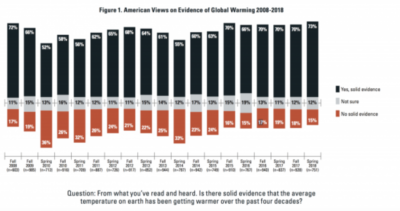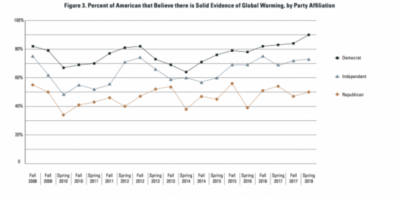
Over the course of the last decade, the National Surveys on Energy and the Environment (NSEE) has surveyed Americans to determine if they believe there is solid evidence of global warming.
The most recent NSEE survey, conducted during April and May of 2018, found that 73% of Americans now think there is solid evidence of global warming – a level higher than the previous record of 72%, revealed during the fall of 2008. This survey is the fifth straight survey in which at least 70% of Americans thought there is evidence that temperatures on the planet are rising.

A solid majority of those surveyed, 60%, now believe human activity is at least partially responsible for this warming, with 34% saying humans are primarily responsible and 26% saying they’re partially responsible. The combined 60% that believes humans are at minimum contributing to global warming surpasses the previous record of 58%.

There is, however, a striking partisan divide among Democrats, Republicans, and independents on whether global warming is occurring. The most recent NSEE findings indicate this divide is large and modestly widening, with the gap between Democrats and Republicans as large as 40% : 90% of Democrats think there is solid evidence of global warming while 50% of Republicans maintain this same view.
So What? We All Know Public Policy Doesn’t Track Public Opinion
These results are good news – I think.
Now, readers may disagree – and despair at the significant minority of people who don’t think climate change is real, and that humans are causing it. To that I retort that at least the numbers are improving, albeit slightly, and this despite massive astroturfing campaigns mounted to the contrary by fossil fuel interests (for more on that score, see this recent DeSmogBlog post, Fake Grassroots Campaigns Deserve Uprooting.
Does this incremental shift in public matter? I would hope so. We all know that there’s a huge disconnect between public opinion and public policy in the United States – due to the money-driven political system. What that means in this regard is that even with a solid proportion of people believing in climate change caused by humans, those percentages alone won’t override the resources the fossil fuel industry can pour into maintaining the current disastrous system.
A couple of points. First, the higher those numbers, and the more solid the support for beliefs, the more difficult it is for ALL politicians to ignore public opinion – particularly those political figures who are exploring alternative mechanisms for financing their campaigns that don’t involve auctioning off their principles to the highest bidder.
Second, even at the level of oligarchs and their minions, however much the fossil fuel industry wants to continue to Drill, Baby, Drill and Frack ’Til You Drop, everyone’s not on board with such a program. Some industries will no doubt profit significantly from a shift away from a fossil fuel economy to a more sustainable system – and we would expect money from those industries devoted to measures to address climate change.
Also, money alone won’t protect the rich from the disastrous climate changed future that’s emerging – and so it’s unsurprising to see some of rich – especially tech stalwarts – embrace the green energy mantra.
Overall, this means I expect some political money spent on a different vision that the Kochs no doubt abhor – but which might benefit all of us.
State Level Action: Some Cause for (Minor) Optimism?
At the moment, all’s not completely lost – the Trump administration’s dreadful environmental record notwithstanding (and a trend I should point out that can only be expected to worsen, despite EPA administration Scott Pruitt’s recent resignation, as I wrote in Pruitt Resigns as EPA Chief: So What?).
States, such as California, continue to pursue saner policies. And some of these policies put states on a collision course with the feds (as I wrote in Trump Regulators and California on Collision Course on Rolling Back Fuel Efficiency Standards).
I‘ll note here that California last week reported some success in mitigating greenhouse gas pollution, according to this California Air Resource Board (CARB) press release:
The California Air Resources Board today announced that greenhouse gas pollution in California fell below 1990 levels for the first time since emissions peaked in 2004—an achievement roughly equal to taking 12 million cars off the road or saving 6 billion gallons of gasoline a year.
“California set the toughest emissions targets in the nation, tracked progress and delivered results,” said Governor Edmund G. Brown Jr. “The next step is for California to cut emissions below 1990 levels by 2030 – a heroic and very ambitious goal.”
Under Assembly Bill 32 passed in 2006, California must reduce its emissions to 1990 levels (431 million metric tons) by 2020. The 2016 Greenhouse Gas Emissions Inventory published today shows that California emitted 429 million metric tons of climate pollutants in 2016–a drop of 12 million metric tons, or three percent, from 2015.
“In California we see the impacts of climate change all around us, but our efforts to curb its worst impacts are on track. We are well positioned to meet the challenge of the 2030 target,” said CARB Chair Mary D. Nichols. “This is great news for the health of Californians, the state’s environment and its economy, even as we face the failure of our national leadership to address climate change.”
Senate Bill 32, signed in 2016, requires the state to go even further than AB 32 and cut emissions 40 percent below 1990 levels by 2030—the most ambitious carbon goal in North America.
I should also note that according CARB, the 13% drop in carbon pollution since 2004 was achieved over a period in which the state economy grew 24% – a fact suggesting that addressing climate change isn’t necessarily incompatible with economic growth. The state’s per capita emissions continue to be among the lowest in the country and fell 23 percent from a peak of 14 metric tons per person in 2001 to 10.8 metric tons per person in 2016 – approximately half as much as the national average.
What Is to Be Done?
Obviously, the scale of the climate problem demands more than piecemeal attention, state-by-state basis. The modest recent developments I here report may make many readers despair. But they suggest that first, the majority of the US public believes climate change is real, and that percentage is increasing. And second, that despite the situation at the federal level – with Trump in the White House and Congress held by Republicans – state level progress on at least reducing current emissions levels is possible. Unfortunately, much more drastic action is necessary.
Our most important fundraising appeal of the year
December is the most critical time of year for Truthout, because our nonprofit news is funded almost entirely by individual donations from readers like you. So before you navigate away, we ask that you take just a second to support Truthout with a tax-deductible donation.
This year is a little different. We are up against a far-reaching, wide-scale attack on press freedom coming from the Trump administration. 2025 was a year of frightening censorship, news industry corporate consolidation, and worsening financial conditions for progressive nonprofits across the board.
We can only resist Trump’s agenda by cultivating a strong base of support. The right-wing mediasphere is funded comfortably by billionaire owners and venture capitalist philanthropists. At Truthout, we have you.
We’ve set an ambitious target for our year-end campaign — a goal of $125,000 to keep up our fight against authoritarianism in 2026. Please take a meaningful action in this fight: make a one-time or monthly donation to Truthout before December 31. If you have the means, please dig deep.
